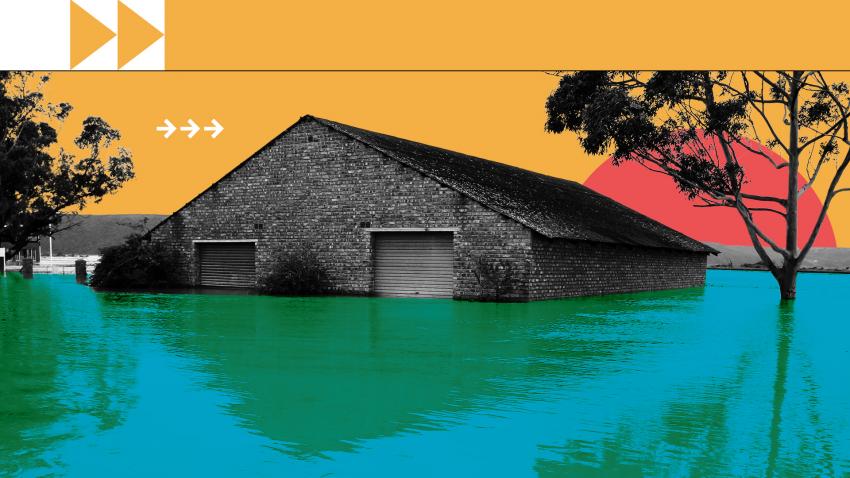The world is falling short on reducing greenhouse gas emissions and in efforts to adapt to the changing climate. Actions and support to developing countries remain insufficient as climate risks grow and impacts increasingly devastate the lives and livelihoods of vulnerable countries and communities.
Moreover, for some people and in some places, it is too late to attempt to adapt to the impacts of climate change. The Intergovernmental Panel on Climate Change (IPCC) has warned that even if effective actions to limit global temperature increase to 1.5°C were put in place, losses and damages stemming from climate change are not preventable, as there is a “locked-in” level of warming that is already causing unavoidable consequences.
The devastating impacts of climate change can result in unquantifiable losses and damages, particularly for many communities and countries in the developing world – loss of lives and livelihoods, as well as degradation of territory, farmland, cultural heritage, indigenous knowledge, societal and cultural identity, biodiversity, and ecosystem services.
Ahead of COP27, we asked Dr. Adelle Thomas, a lead author of the IPCC’s 2022 report on Impacts, Adaptation and Vulnerability, and the Special Report on 1.5°C to shed more light on the issue, what it means for vulnerable populations exposed to the worsening climate impacts, and the growing imperative to address what’s at stake.

Q: What is meant by “loss and damage” in the context of climate change?
Adelle Thomas: Loss and damage means different things to different groups and there is no agreed upon definition of loss and damage within the UN Framework Convention on Climate Change (UNFCCC). However, loss and damage can generally be understood as the negative impacts of climate change that occur despite, or in the absence of, mitigation and adaptation.
Loss ad damage is often categorized as either economic or non-economic. Economic loss and damage are negative impacts that we can assign a monetary value to. These are things such as the costs of rebuilding infrastructure that has been damaged due a flood, or the loss of revenue from agricultural crops that were destroyed due to drought.
Non-economic loss and damage are negative impacts where it is difficult or infeasible to assign a monetary value to. These are things such as trauma from experiencing a tropical cyclone, loss of community due to displacement of people, or loss of biodiversity.
Loss and damage can occur due to both extreme events – such as heat waves and storms – and slow onset events – such as sea-level rise or ocean acidification.
Q: What does the IPCC say about losses and damages – in terms of current and future risks, and required action and solutions?
Adelle Thomas: The IPCC Working Group II Report on Impacts, Adaptation and Vulnerability (part of the Sixth Assessment Report) is the most extensive assessment of losses and damages to date.
Four key messages from the report are:
1. Losses and damages are already being experienced: Existing global warming of 1.1°C has already caused dangerous and widespread losses and damages, led to disruptions in nature as well as affected the lives of billions of people, despite people’s efforts to adapt.
2. Future losses and damages will rise with increased global warming: With increasing global warming, losses and damages increase and become increasingly difficult to avoid, while strongly concentrated among the poorest vulnerable populations.
3. Losses and damages are unavoidable and are unequally distributed: Adaptation cannot prevent all losses and damages. Losses and damages are disproportionately experienced by developing countries and by vulnerable groups, such as people of low socio-economic class, migrant groups, the elderly, women and children.
4. Losses and damages are not comprehensively addressed by current financial, governance and institutional arrangements: Particularly in vulnerable developing countries, existing international, national and sub-national approaches to address loss and damage are insufficient.
Q: What are the limits to adaptation?
Adelle Thomas: A key point in understanding losses and damages is that they can occur despite adaptation and even before limits to adaptation have been reached.
Limits to adaptation are the point at which adaptive responses cease to provide protection against climate impacts. So, when an adaptation limit is reached, then losses and damages will escalate as adaptation is no longer able to reduce negative impacts. However, even before reaching adaptation limits, losses and damages can and do occur.
Adaptation limits can be differentiated into hard and soft limits:
- Soft limits are those for which no further adaptation options are feasible currently but some options might become available in the future. For example, a farmer may not currently be able to afford the cost of irrigation or drought-resistant crops, but these adaptation options may become available to her in the future if she can increase her financial resources.
- Hard limits are those for which existing adaptation options will cease to be effective and additional options are not possible. For example, restoration of coral reefs as an ecosystem-based adaptation option faces hard limits beginning at 1.5°C, as this is when ocean acidification and warming greatly reduce the survivability of coral reefs.

Q: What are some of the findings in specific regions, including in Small Island Developing States and in Africa?
Adelle Thomas: The IPCC finds that losses and damages are disproportionately experienced by vulnerable developing countries.
Small Islands are one of the regions that are already facing disproportionate losses and damages and where projected losses and damages are particularly high. For Small Islands in particular, 1.5°C is a critical threshold beyond which these islands may be unable to adapt to climate change.
Sea-level rise poses an existential threat, particularly for low-lying areas that are already at or below current sea levels. There is a risk of permanent and irreversible loss of terrestrial, marine and coastal biodiversity as well as the services that these ecosystems provide, such as coastal protection from storms and supporting livelihoods such as fisheries.
There is the risk of economic decline due to losses and damages, and failure of sectors that these islands are dependent on such as agriculture and tourism. Losses and damages may lead to reduced habitability of islands, meaning that there will be displacement or permanent migration of people from their homes along with non-economic losses such as loss of sense of place, community and culture.
In Africa, losses and damages are also already being experienced and will escalate with global warming. Some of the projected losses and damages for the African region are species extinction and reduction, irreversible loss of ecosystems and their services, including freshwater, land and ocean ecosystems. There are risks to food security, risk of malnutrition, and loss of livelihoods due to reduced food production from crops, livestock and fisheries.
Losses and damages may include increased human mortality and morbidity due to increased heat and infectious diseases, inequality and poverty rates, risk to water and energy security due to drought and heat, and reduced economic output and growth.
Q: The UN Secretary-General has said that addressing the issue of loss and damage is a moral imperative. As a scientist, what is your message to delegates on loss and damage?
Adelle Thomas: The scientific evidence is very clear that losses and damages are already being experienced, that they will rise with global warming and that they are unavoidable and unequally distributed, with disproportionate effects on developing countries and vulnerable groups.
Losses and damages are a current reality and there is a clear need for financial, governance and institutional arrangements at multiple levels to address these issues.
Prolonged delaying of improving financial, governance and institutional arrangements to address loss and damage will only result in those that are already most vulnerable and experiencing loss and damage facing ever increasing levels of negative impacts of climate change.
Addressing loss and damage
At COP27, the UN Climate Change Conference in Egypt in November 2022, after days of intense negotiations, countries reached agreement on establishing a fund to compensate vulnerable nations for ‘loss and damage’ from climate-induced disasters.
Learn more about the Warsaw International Mechanism for Loss and Damage, which was adopted at the UN Climate Conference in 2013 to begin a process to address the issue, and Article 8 of the Paris Agreement, a provision in the Paris Agreement, which was adopted in 2015, to strengthen the Warsaw Mechanism.
The UN System together with its partners have been providing financial and technical support to countries to address issues related to loss and damage. Read more about the Secretary-General’s Early Warning for All initiative to scale up efforts to address loss and damage.

